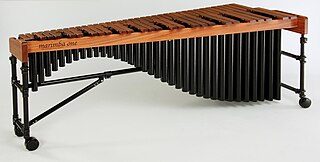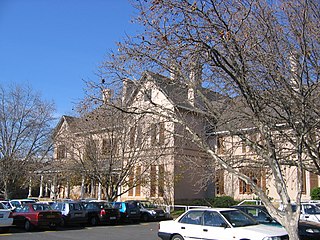
A percussion instrument is a musical instrument that is sounded by being struck or scraped by a beater including attached or enclosed beaters or rattles struck, scraped or rubbed by hand or struck against another similar instrument. Excluding zoomusicological instruments and the human voice, the percussion family is believed to include the oldest musical instruments. In spite of being a very common term to designate instruments, and to relate them to their players, the percussionists, percussion is not a systematic classificatory category of instruments, as described by the scientific field of organology. It is shown below that percussion instruments may belong to the organological classes of idiophone, membranophone, aerophone and cordophone.

In music performances, rhythm guitar is a technique and role that performs a combination of two functions: to provide all or part of the rhythmic pulse in conjunction with other instruments from the rhythm section ; and to provide all or part of the harmony, i.e. the chords from a song's chord progression, where a chord is a group of notes played together. Therefore, the basic technique of rhythm guitar is to hold down a series of chords with the fretting hand while strumming or fingerpicking rhythmically with the other hand. More developed rhythm techniques include arpeggios, damping, riffs, chord solos, and complex strums.

The marimba is a musical instrument in the percussion family that consists of wooden bars that are struck by mallets. Below each bar is a resonator pipe that amplifies particular harmonics of its sound. Compared to the xylophone, the marimba has a lower range. Typically, the bars of a marimba are arranged chromatically, like the keys of a piano. The marimba is a type of idiophone.

The South African music scene includes both popular (jive) and folk forms like Zulu isicathamiya singing and harmonic mbaqanga. Other popular genres are Marabi, Kwaito, house music, Isicathamiya, Gqom, rock music, hip hop and Amapiano.

The music of Togo has produced a number of internationally known popular entertainers including Bella Bellow, Akofah Akussah, Afia Mala, Itadi Bonney, Wellborn, King Mensah and Jimi Hope.

Edwin H. Kramer is a South African-born recording producer and engineer. He has collaborated with several artists now in the Rock and Roll Hall of Fame, including Jimi Hendrix, the Beatles, David Bowie, the Rolling Stones, Led Zeppelin, Eric Clapton, the Kinks, Kiss, John Mellencamp, and Carlos Santana, as well as records for other well-known artists in various genres.

Axis: Bold as Love is the second studio album by the Jimi Hendrix Experience. It was first released by Track Records in the United Kingdom on December 1, 1967, only seven months after the release of the group's highly successful debut, Are You Experienced. In the United States, Reprise Records delayed the release until the following month. The album reached the top ten in the album charts in both countries.
Xhosa music has long been a major part of the music of South Africa, especially in the field of jazz. Since olden times, singing has been a tradition and part of culture among the Xhosas.

Live at Woodstock is a posthumous live album by Jimi Hendrix released on July 6, 1999. It documents most of his performance at the Woodstock Festival on August 18, 1969, and contains Hendrix's iconic interpretation of "The Star-Spangled Banner" and other songs from the original festival film and soundtrack album.

In many parts of sub-Saharan Africa, the use of music is not limited to entertainment: it serves a purpose to the local community and helps in the conduct of daily routines. Traditional African music supplies appropriate music and dance for work and for religious ceremonies of birth, naming, rites of passage, marriage and funerals. The beats and sounds of the drum are used in communication as well as in cultural expression.

The South African College of Music, abbreviated as SACM, is a department of the Faculty of Humanities at the University of Cape Town. It is located on the university's Lower Campus in Rondebosch, Cape Town.
Mountain Records is a record label started in Cape Town, South Africa in 1980 by Patrick Lee-Thorp.
Amampondo is a South African percussion ensemble that was started by Dizu Plaatjies in Langa, Cape Town in 1979. The name in Mpondo means people of Mpondo or Pondoland, a kingdom in the Eastern Cape where most of the band's members grew up. The other founding members were Simpiwe Matole; Michael Ludonga; Mzwandile Qotoyi; Leo Mbizela and Mandla Lande. National Geographic called them "one of the most interesting and experimental groups in South Africa".

Andrew John Preston "Andi" Spicer was an English electroacoustic classical music composer who used electronics in his compositions.
Michael Blake is a South African contemporary classical music composer and performer. He studied in Johannesburg in the 1970s and was associated with conceptual art and the emergence of an indigenous experimental music aesthetic. In 1976 he embarked on 'African Journal', a series of pieces for Western instruments that drew on his studies of traditional African music and aesthetics, which continued to expand during two decades in London until he returned to South Africa in 1998. From around 2000 African music becomes less explicit on the surface of his compositions, but elements of rhythm and repetition remain as part of a more postcolonial engagement with material and form. He works in a range of styles including minimalism and collage, and now also forages for source material from the entire musical canon.
Isak Roux is a South African born German composer born in 1959. He is known for his arrangements of South African music, especially his work with the musical groups Ladysmith Black Mambazo and Kwela Tebza.

The Xhosa people, or Xhosa-speaking people are a Bantu ethnic group whose traditional homeland is primarily the Cape Provinces of South Africa. They are the second largest ethnic group in Southern Africa and are native speakers of the IsiXhosa language.
Nofinishi Dywili (1928–2002) was a traditional Xhosa musician who achieved much recognition throughout her lifetime. She is regarded as the master of "uhadi" music and the master of Xhosa song productions such as The Bow Project.
The Uhadi, a musical bow, is a traditional Southern African Xhosa musical instrument. It is a large unembraced musical bow which is attached to a resonator and played by percussion. The length of the string bow ranges from 115 to 130 centimeters. Similar musical bows in Southern Africa include the ‘’thomo’’ in Sotho music and the ‘’ugubhu’’ in Zulu music.












